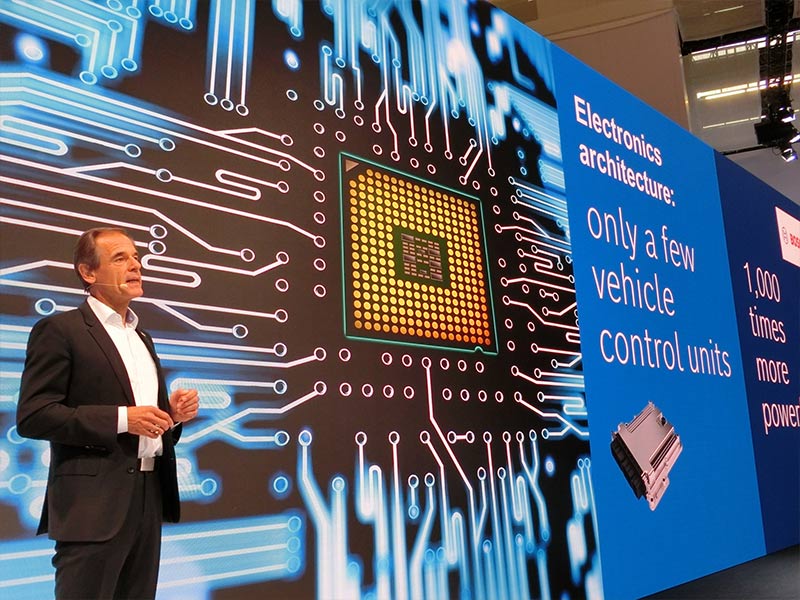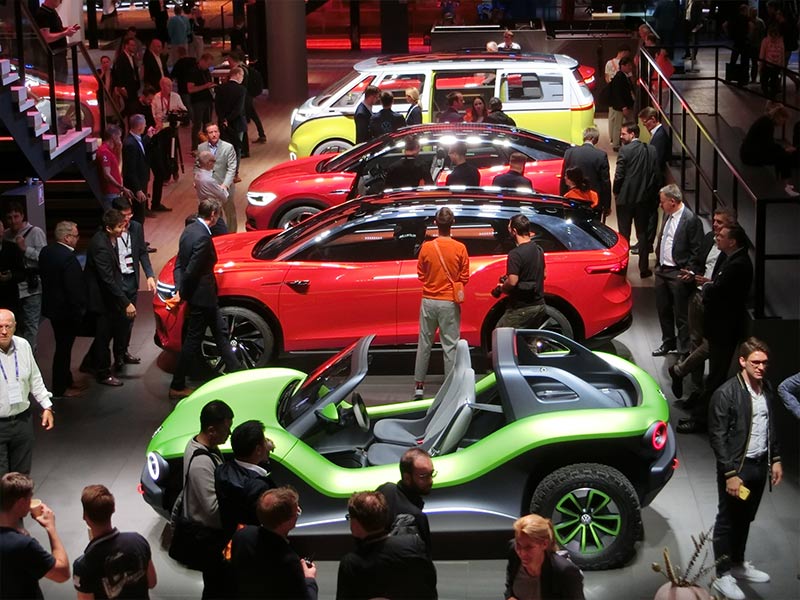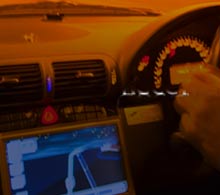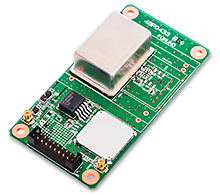Articles for ITS market Android Automotive pays attention to V2X - Report from the Frankfurt Motor Show 2019 in Germany -
Social change impact felt at the Frankfurt Motor Show 2019 in Germany
Japanese car manufacturers other than Honda, GM and FCA (Fiat Chrysler Automotive) have withdrawn. The Frankfurt Motor Show 2019 (IAA 2019) has reached a major milestone.
The relationship between "people and cars" and "cars and society" has changed significantly due to new businesses such as the sharing economy, new technologies such as automated driving and connected cars. Such social changes continue to have a major impact on the world's leading motor shows.
What is happening now in Germany, a developed country in the automotive industry? They introduced a new project that I noticed in the venue.
The calming of the automated driving boom
Exhibits related to automated driving have become inconspicuous.
The reason is because it is difficult to mass-produce level 3 or higher automated driving at the consumer vehicle level.
Major German parts manufacturers such as Bosch and Continental are currently planning for mass production at level 2 advanced or level 3 with limited capabilities such as or lower operating speed.
In automated driving there are 6 automated driving levels which are levels 0 to 5. Level 0 refers to manual driving. For levels 1 and 2 the automated driving assiststhe driver, who provides all advanced driving. At level 3 or higher the driving is controlled by the automated car system. However at level 3 if the automated system determines it cannot continue driving, it returns to manual mode and driver control.
Between level 2 and 3 where the driving control shifts from people to vehicles there is a “wall for social implementation (mass production)”. Vehicle manufacturers have realized that the walls are extremely large as they continue with public road automated driving tests.
On the other hand, in the area of service vehicles (public transportation), social experiments at level 4 and above will proceed. However here too there are walls. There is a big difference in the acceptance system of local governments by region. For example, not only regulations on automated driving but also on car sharing (ride sharing). Volkswagen officials confirm this situation, “Even in the EU, there is no unified view even in Germany. Currently it is not resolved.”
Under such circumstances, both the personal car and service car development has slowed down the pace of automated driving mass production, which had previously been in rapid expansion.
Data platform in service area
With the development of automated driving and electrification a common platform for car manufacturers has become important for vehicle data and customer data. Two competing formats are introduced from this perspective.
Android Automotive (Embedded System)
The presence of Android is increasing in the Embedded System.
According to Google (parent company: Alphabet Inc.), the Embedded System that the company calls Android Automotive has a 45% share. The car manufacturers that are using it are limited to Honda, Nissan, Mitsubishi, BMW, Fiat, etc. However major auto parts manufactures such as Bosch and Denso are listed in various countries.
Going back a bit, Google was first involved in the automotive industry in 2005 jointly developing and providing software using Google Maps with some auto parts manufacturers.
After that in 2010 Google Maps' API (Application Programming Interface) was released to the in-vehicle device for open source car navigation. In 2015 Android Auto entered the automotive industry through its own route. In addition, they made technical rules that connected the mobile Android phone and the in-vehicle device. This was response to Apple's “iOS in the car (later called Apple CarPlay)”.
In 2020 the Embedded System “Android Automotive”, has become major in the industry and will be in full swing. At the time of the Android Auto announcement in 2015 they confirmed a full-scale entry into the in-vehicle OS and have already collaborated with automobile related companies as mentioned above. At present Android Automotive is mainly in infotainment areas such as car navigation, video distribution, and SNS. Infotainment incorporates the fusion of information and entertainment.
In the future there is a possibility of expanding the range of Android Automotive activities in areas related to vehicle motion performance or service areas such as ride sharing. This is in cooperation with Waymo, an automated driving development company under Android.
System fusion in V2X targeted by Continental
Continental is trying to embody a new concept of V2X that adds "Vehicle and infrastructure communication (road-to-vehicle communication: V2I)" to "vehicle-to-vehicle communication (V2V)".
Here, according to the company's explanation, V2X currently has two systems in the world.
One is the DSRC (Dedicated Short Range Communication) widely used in Europe, America and Japan. In Japan it is used for ETC (Electric Toll Collection System). DSRC uses different frequency bands depending on the country and region, such as 5.8 GHz, 5.9 GHz and 700 MHz bands.
The other is a cellular TCS (Telematics Control System) using a telephone line. This is in much demand throughout China.
A system that combines these two methods into one platform is called "Hybrid V2X" from Continental.
In demonstrations using tablets examples of alerts when emergency vehicles approach and cases at intersections with poor visibility were introduced. “In a world where various vehicles are mixed in various parts of the world, it is natural that the "Hybrid V2X" will be put into practical use in the future,” the company's development staff confirmed.
The test with the first machine has already been completed and it is aiming for mass production in the next 2-3 years.
Writer introduction

Mr. Kenji Momota Automotive journalist
His major is the world automotive industry and he is also familiar with the energy industry, IT and the aging society problem as the related fields. He acts around the world based in Japan and USA and writes for the general magazines, the technology journals and the automotive related media etc.
He is also commentator of motor race and world's motor show on TV program based on his career of the driver of Indy Racing League and NASCAR. In recent years, he has been covering about a paradigm shift from developed countries to developing countries, the motorized vehicle like EV and the telematics.
FURUNO ITS Journal
Click here for the latest articles after 2022 (in Japanese)2022
- The "realistic" self-driving roadmap shown by the Japanese government and a hands-on report on the latest Subaru EyeSight X
- Will FCVs (Fuel Cell Vehicles) Become Popular? ~New Movement in Toyota and Honda~
- The 'Complete' online sales of new cars start in Japan. Will this new way of buying cars take root?
- Many Firsts! On-Site Report from Tokyo Auto Salon 2022 - The author, who knows what goes on behind the scenes, looks back on 40 years of history. -
2021
- "Moving toward zero traffic fatalities for four-wheeled and two-wheeled vehicles globally in 2050" ~Experience on Honda's latest safety technologies~
- Tsuneishi Shipbuilding's building and DX, an exclusive visit to the main factory
- Japan's Smart City: New Moves toward Practical Use
- When will self-driving buses (service cars) be put to "full-scale" practical use?
- Utilization vehicle data during disasters
- Toyota-led Connected Technology to Transform Commercial Vehicle Business -From light trucks to large trucks and buses-
- Toyota enters the connected car "Personalization" business
- Japanese automakers' carbon-neutral strategies swept up in ESG investment
- Drive experience of the latest autonomous vehicle models and advanced driving support systems
- Will carbon neutrality accelerate the trend to strengthen LCA (Life Cycle Assessment)?
- Semiconductor shortage exposes realities of the automotive industry
- Online Autonomous Driving Contest Enhancing development of Human Resources
2020
- What happens to CASE when gas cars are banned in Japan?
- When will Flying Cars be launched?
- Expectation vs. reality:Autonomous Driving in Japan
- V2X, Becoming increasingly important in autonomous driving
- Technology of Subaru “EyeSight X”
- Lifestyle-oriented French cars gain popularity in Japan
- Human-oriented smart cities are wanted
- MaaS and CASE, how would automotive industry change after COVID-19?
- The beginning of virtualization era, triggered by COVID-19
- Trend of EV shift and consumer demands
- TOYOTA Press conference about ADAS - Releasing algorithm for "sudden acceleration suppression during attempted sudden acceleration" free of charge -
- The Japanese automotive industry in 2020 - 3 turning points -
- "Using a smartphone while driving" and "Level 3 automated driving"
2019
- Motor show business model is at a turning point - Tokyo Motor Show Report -
- Commercialization and monetization of MaaS - ITS World Congress Singapore Report -
- Android Automotive pays attention to V2X - Report from the Frankfurt Motor Show 2019 in Germany -
- Automobile Distribution Revolution and DCM (Data Communication Module)
- Connected business potential and newly proposed "eMaaS" by Honda
- 5G services for practical use are multiplying
- Connectivity technologies attracting attention due to frequent traffic accidents
- Shanghai Motor Show report -SUV, EV, Automated car & 5G-
- Drone Business roadmap and updates to Michibiki (Quasi-Zenith Satellite System)
- MaaS (Mobility as a Service) "town development." Full-scale promotion for a national project
- CES organizer states "Data Period in 2020s." Transformation of the Automotive Industry in CES, US "-CES2019 Report-"
- "Return to Origin" directed towards the age of change, automatic operation and connectivity
2018
- New proposal for Private Car Automated Driving Level and other Hot 5G Technology Topics
- Standardized EV charging infrastructure concerns in Europe, US, Japan and China - Kobe EVS 31 field report -
- Touring a pure car carrier and a test drive of the latest hybrid car
- Planning stage products are exhibited at the newly established visualized mobility service "TOYOTA MOBILITY SHOWROOM".
- Potential “Community Car-share” program promoted by local residents
- CES Asia Report 2108
- Companies attempt new Vehicle-to-Infrastructure communications, including traffic volume measurements and vehicle positioning. -ITS Asia Pacific Forum in Fukuoka-
- Geneva show in Switzerland. Flying cars and MaaS (Mobility as a Service) were hot topics.
- EV (Electric Vehicle) proposals by country
- MaaS competition through service mobilization, M & A and technical field collaboration is accelerating. - The CES 2018 Report -
2017
- Big data’s initiative and fight for the automotive industry. Cooperation among companies becomes increasingly important.
- Connected car and road-to-vehicle communication automatic operation
- ETC (Electronic Toll Collection) and ETC2.0. Current situation and projected future
- Rapid development of sharing economy
- Germany is first to recognize level 3 automated driving
- ITS EU 2017 Field Reports -Automatic Operation and the eCall-
- From Infotainment to ITS, the competitive area is spreading in the car big data industry.
- GTC (GPU Technology Conference) Report and the de facto standardization of AI (artificial intelligence)
- Renesas' new challenge! "e-AI Solution" and "Renesas Autonomy"
- The Automobile industry is shifting from a manufacturing industry to a service industry.
- The movement toward accident countermeasures for aging drivers in Japan
- Fusion of ride sharing and fully automated driving is advancing in the USA.
2016
- Overview of the Quasi-Zenith Satellite System (QZSS) and advancements toward full-scale practical use including the Tokyo Olympic Games - G-space EXPO 2016 report-
- Japan’s automated driving project "SIP-adus" will be a large demonstration experiment.
- The International Home Care & Rehabilitation Exhibition. There were many car manufactures with exhibits booths at this show.
- Japanese car manufacturers starting to concentrate on strengthening the ADAS system
- A new movement of legislation for autonomous cars
- Cyber Security and “AGL”, the new OS for automotive are hot topics in the connected car industry
- “High precision 3D map” the key future of autonomous car and pedestrian dead reckoning
- Chinese “BAT” is accelerating their business in the EV (Electric Vehicle) market
- Tesla's original connection to Taiwan and the new transportation system technologies.
- "The main topic" of the Geneva Motor Show was how to strengthen "pedestrian protection"
- The probe data business is getting more competitive
- Reporting directly from the 2016 CES show "Data services will soon become the main revenue source of automotive industry"
2015
- Do the automated driving systems need the GNSS (Global Navigation Satellite System) ?
- ETC Version 2.0 is coming soon. A new service was announced at the Tokyo Motor Show and the possibility that is could be used as a device for older drivers.
- "Connected Horizon" and "eHorizon". Germany's leading parts supplier accelerates strengthening of "Big Data" for business



 Daimler exhibits an automated driving test vehicle jointly developed with Bosch as the number of exhibits related to automated driving decreases.
Daimler exhibits an automated driving test vehicle jointly developed with Bosch as the number of exhibits related to automated driving decreases. Google explains the current status of Android Automotive
Google explains the current status of Android Automotive Explanation screen about "Hybrid V2X" that Continental aims for mass production in 2 to 3 years
Explanation screen about "Hybrid V2X" that Continental aims for mass production in 2 to 3 years Bosch strengthens development of CASE (Connected, Autonomous, Shared, and Electric)
Bosch strengthens development of CASE (Connected, Autonomous, Shared, and Electric) VW exhibition booth monopolized by EV
VW exhibition booth monopolized by EV GPS/GNSS Receiver&Chips and Modules (positioning and timing)
GPS/GNSS Receiver&Chips and Modules (positioning and timing)